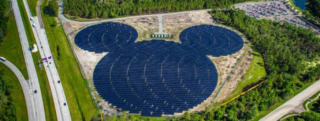- Resources
- Why Disney World is betting on clean energy
Resources
Why Disney World is betting on clean energy
Published: February 4, 2019 by Jake Hiller
“Environmental stewardship and conservation were engrained in The Walt Disney Company from the beginning,” Angie Renner recently told me. Angie is an Environmental Integration Director at Walt Disney World Resort, and today she says the company is investing in new technologies and renewable energy projects that have thus far cut greenhouse gas emissions nearly in half. Why? Because as a Bloomberg story just noted, warmer temperatures are already impacting the “the comfort and health and well being of [the resort’s] customers.”
In other words, climate change is bad for business. But as I’ve seen firsthand, companies that invest in clean energy, engage customers in sustainability efforts and leverage their influence to drive smart policies can turn a downside risk into tangible cost-savings, customer retention and global leadership.
I recently caught up with Angie to learn more about the company’s sustainability initiatives and successes and its efforts to provide environmental education to the hundreds of thousands of guests who visit the iconic Disney resorts each day.
Here is an edited transcript of our conversation.
How has Disney evolved over the years to adopt clean and renewable energy?

Walt’s legacy of caring for the environment is really dear to our heart, and we’re always looking for ways to use resources wisely and protect the planet it’s part of who we are. Today, we are striving towards three main environ
mental goals: divert 60 percent of our waste from landfills by 2020, reduce net emissions 50 percent (from 2012 levels) by 2020, and reduce water consumption across the board.
We’ve had solar projects since the early 1980s, but our first large-scale venture into clean and renewable energy was our iconic 5-megawatt, 22-acre Mickey solar array which came online in 2016 at Walt Disney World. It’s shaped like a giant Mickey head—22 acres of solar panels! It’s operated by Duke Energy and located near Epcot, and it helps power some of our attractions in the theme parks.
Our buses that transport guests were also one of the first fleets in the nation and among the largest in Florida to use R50 renewable diesel fuel. The fuel is made from used cooking oil and non-consumable food waste. To date, our entire bus fleet has been converted into using renewable fuel.
The final thing I’ll mention is our focus on energy reduction and efficiencies. One of my favorite large-scale LED projects that we have here is when we light up the Cinderella Castle with 170,000 LED lights for the holidays it only uses the energy of about four coffee pots.
Last year you announced a new solar farm that will be 10 times larger than the Mickey solar array. Can you share some details?
That’s right! The 270-acre solar facility is located just outside of Disney’s Animal Kingdom Theme Park near Orlando. The solar array has about half a million panels that’s enough to power 10,000 homes annually or two of our four theme parks. It provides renewable solar power to the entire Reedy Creek Improvement District, which includes Walt Disney World Resort. This is made possible through a collaboration with the Reedy Creek Improvement District and Origis Energy USA.
How does Disney work to bring sustainability information to your guests?
Our hope is to always inspire our guests to want to protect the planet as much as we do. One of my favorite examples of this is Disney’s Animal Kingdom, which is all about conservation, protecting the natural world, animals and the environment. Guests are learning about things that they can do to make a difference in the world and the environment, while they’re having fun at the same time.
Follow Jake Hiller on Twitter.
